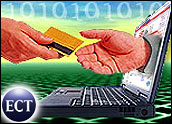
Even with a steady stream of database breaches that lead to potential identity theft making headlines nearly every day, e-commerce continues to grow steadily, with many consumers increasingly sanguine about turning over sensitive information such as their credit card numbers to online merchants.
Still, even boosters of e-commerce say ID theft and related security issues are likely acting as something of a drag on e-commerce growth, with study after study showing that abandoned shopping carts and purchases never completed can be tied to concerns about sharing key data.
Searching for a Better Way
Is there a better way for buyers to pay for online purchases? Many Internet companies seem to think so, with eBay’s PayPal and soon, if reports are to be believed, Google’s GBuy, attempting to address the trust and payment issue.
MODA Solutions, meanwhile, thinks one solution is even simpler and involves an existing relationship built on deep trust: Online banking and bill paying. Combine that with a simple e-mail address, the company believes, and you have a payment solution that is far safer and that consumers are more likely to trust.
The result is Secure e-bill, an alternative to credit card payments. Shoppers provide merchants only their e-mail address and are sent an invoice, which they then pay through their regular online bank, the same way they would a monthly utility bill or other payment.
“Finding ways to make consumers more comfortable buying online is a growth market,” Marwan Forzley, President and CEO of MODA Solutions, told the E-Commerce Times. “We have taken a fairly simple approach to addressing this issue and our solution benefits everybody in the value chain — the consumers and the merchants.”
Untapped Customers for Big Al
MODA launched Secure e-Bill in May of 2005 to strong positive reaction from merchants, Forzley said. “Merchants in general are looking for alternative payment options,” he added.
While the e-mail and online banking option offers merchants the chance to reduce fraud and therefore cut down on their potential losses, the biggest upside is in gaining customers who might otherwise have abandoned their shopping carts at the virtual checkout counter.
ToolKing.com found that 60 percent of the customers who use Secure e-Bill are new customers to the site, for instance, and at Big Al’s Online, the Web site of the Canada-based multi-channel aquarium supplies retailer, 39 percent of the customers who used the service to pay are customers they’d “never seen before,” Forzley said.
Dan Hamilton, director of eCommerce for Big Al’s, said the company is saving money because the fees it pays to MODA are lower than credit-card processing fees.
“Repeat order rates have exceeded our expectations,” he said, adding that the service has boosted revenue while decreasing processing costs at the same time.
“They’re tapping into an audience that doesn’t buy online,” Forzley said. “They’re the audience that might call the 1-800 number instead to do the same purchase simply because they feel better about giving their credit card information to a real person.”
The e-bill option is built into a merchant’s Web site using APIs similar to those for credit-card processing and is offered by some payment solutions re-sellers, such as Cardinal Commerce, which offers it alongside enhanced security options for traditional credit card payments. It can take a little longer to complete a purchase with the e-bill option, since some merchants wait for a shopper to complete the bill pay transaction to ship a purchase, but most are completed within two days.
A Thorny Problem
Given the rise of identity theft tied to Web purchases and high-profile database breaches in which credit card information is released inadvertently or information is stolen by hacking, a range of possible solutions has emerged.
Federal legislation is pending that would require notification of those affected by breaches, mimicking a rash of state laws already on the books. Credit card and payment processing companies have offered various protection programs meant to give shoppers more confidence and vendors have begun to offer credit monitoring and even guaranteed ID-theft-prevention services.
“There’s no doubt it’s something that’s a worry hanging over the industry, but so far it’s not something that has slowed growth in any measurable way,” said Forrester Research analyst Carrie Johnson.
Forzley said one advantage of the Secure e-Bill approach is that it leverages the trust consumers have with their banks and the billions those banks have spent on digital security. In fact, financial sites often boasting stronger security than typical Web sites where other types of transactions take place.
“People are very active when it comes to online banking. They trust their banks,” he added. “They log in and on average already pay 10 to 14 bills per month. Online bill pay is a mainstream service these days. There are a large number of people who trust it.”
Merchants also like that after a customer pays with Secure e-Bill, the merchant’s invoice will continue to appear in their online banking records, serving as a reminder that helps to drive repeat sales.
“There are lots of studies showing that people would complete more purchases if they felt there was a safer option out there,” Forzley said. “We are giving them an alternative that does that.”














































Social Media
See all Social Media